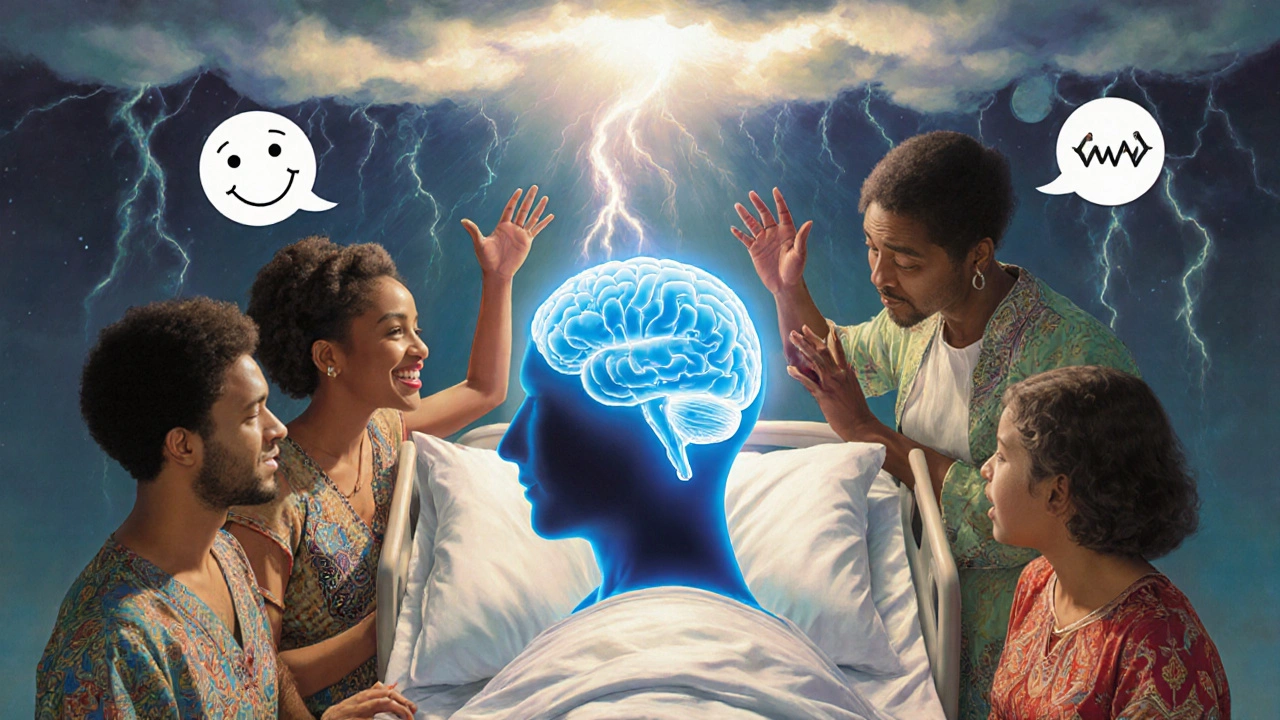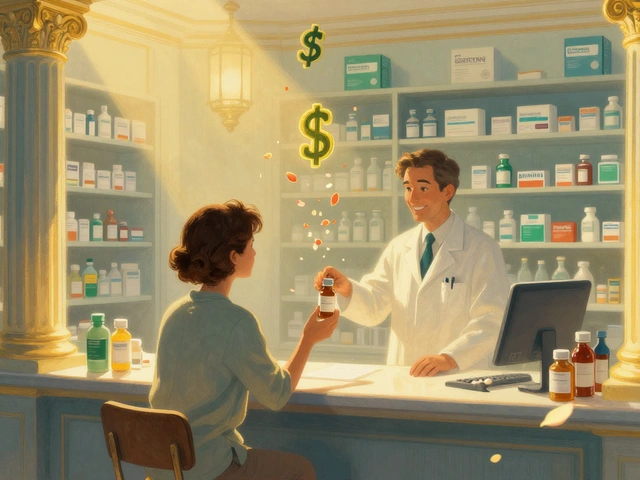What Are the Two Main Types of Stroke?
There are two main kinds of stroke: ischemic and hemorrhagic. Together, they make up nearly every stroke case in the U.S. About 87% of strokes are ischemic. That means a clot blocks blood flow to part of your brain. The other 13% are hemorrhagic - a blood vessel bursts and bleeds into or around your brain. These aren’t just different in cause. They behave differently, show different symptoms, and need completely different treatments.
If you don’t know which type you’re dealing with, you could get the wrong treatment - and that can be deadly. Giving a clot-busting drug to someone with a bleed can make things worse. That’s why emergency teams use CT scans right away to tell them apart. The faster you get to the hospital, the better your chances.
Ischemic Stroke: The Blockage
Ischemic strokes happen when something blocks an artery feeding your brain. Think of it like a clogged pipe. The clot might form right in your brain (thrombotic stroke), or it might travel from your heart or neck (embolic stroke). About half of all ischemic strokes are thrombotic, often caused by plaque buildup from high cholesterol or smoking. Another 20% are embolic, usually linked to atrial fibrillation - an irregular heartbeat that lets clots form in the heart.
There’s also a third group: cryptogenic strokes. These are ischemic strokes with no clear cause, even after full testing. They make up about 30% of ischemic cases. Doctors are still working to find hidden causes - sometimes it’s a tiny undetected heart rhythm problem or a small hole in the heart.
Symptoms usually come on slowly. You might wake up with numbness in your hand, or your speech might get slurred over 10 or 20 minutes. People often dismiss it as tiredness or a pinched nerve. But if you wait too long, brain cells die. That’s why the FAST acronym matters: Face drooping? Arm weakness? Speech trouble? Time to call 911.
Hemorrhagic Stroke: The Burst
Hemorrhagic strokes are less common but often more violent. Instead of a blockage, a blood vessel ruptures. This causes pressure to build up inside your skull, crushing brain tissue. Two types exist: intracerebral hemorrhage (bleeding inside the brain) and subarachnoid hemorrhage (bleeding on the surface, often from a ruptured aneurysm).
High blood pressure is the #1 cause. Nearly 80% of intracerebral bleeds happen because decades of uncontrolled hypertension have weakened small arteries. The rest come from aneurysms - balloon-like bulges in artery walls that can burst without warning.
The symptoms hit like a lightning strike. People describe it as the “worst headache of my life.” It’s not a migraine. It’s explosive, sudden, and often followed by vomiting, confusion, or loss of consciousness. Other signs include one pupil larger than the other, seizures, or extreme agitation. Unlike ischemic strokes, these symptoms rarely creep in - they explode.
How Symptoms Differ Between Stroke Types
It’s not just about speed. The symptoms themselves can give clues.
- Headache: 92% of hemorrhagic stroke patients report it. Only 19% of ischemic patients do.
- Eye problems: Half of hemorrhagic stroke patients have trouble moving their eyes. Less than 7% of ischemic patients do.
- Pupils: One pupil may be wider than the other in hemorrhagic strokes. That’s rare in ischemic.
- Seizures: Happen in nearly 1 in 6 hemorrhagic cases. Almost never in ischemic.
- Agitation: Nearly 80% of hemorrhagic stroke patients are restless or confused. Only 7% of ischemic patients are.
These differences aren’t perfect - some ischemic strokes can cause headaches, and some hemorrhagic strokes are mild. But when you see a sudden, severe headache with confusion or unequal pupils, treat it like a hemorrhage until proven otherwise.

How Treatment Varies by Stroke Type
There’s no one-size-fits-all fix. Treatment depends entirely on what’s happening inside your brain.
For ischemic strokes, the goal is to dissolve or remove the clot. If you get to the hospital within 4.5 hours, you might get tPA (alteplase) or tenecteplase - drugs that break up clots. For larger clots in major arteries, a mechanical thrombectomy can be done. This is a minimally invasive procedure where a device is threaded through your groin to pull the clot out. Studies show this works even up to 24 hours after symptoms start, if imaging shows salvageable brain tissue.
Hemorrhagic strokes need a different approach. You can’t give clot-busters here - it would make the bleed worse. Instead, doctors focus on stopping the bleeding and reducing pressure. If it’s an aneurysm, they might place tiny coils inside the vessel (coiling) or clamp it shut with a metal clip (clipping). If there’s a large bleed inside the brain, they might use a minimally invasive technique to drain the blood and reduce swelling. In some cases, medications to lower blood pressure are the first line of defense.
One big shift in recent years? Treatment is no longer just about time - it’s about tissue. Advanced imaging can now show which parts of the brain are still alive but starving for blood. That means even if you’re 8 hours in, if the brain tissue is still viable, you might still be a candidate for treatment.
Preventing Ischemic Stroke
If you’ve had an ischemic stroke, your risk of another one is high. Prevention is about managing the root causes.
- Control atrial fibrillation: If you have AFib, your stroke risk goes up fivefold. Blood thinners like apixaban or rivaroxaban reduce that risk by 60-70%. Don’t skip doses.
- Lower cholesterol: Statins aren’t just for your heart. They stabilize plaque in brain arteries, cutting stroke risk by up to 30%.
- Take aspirin or clopidogrel: For people without AFib, daily low-dose aspirin (81 mg) or clopidogrel reduces the chance of a second stroke by 25%.
- Manage diabetes and high blood pressure: Both damage blood vessels over time. Keeping your numbers in range cuts stroke risk significantly.
- Eat the Mediterranean diet: Fruits, vegetables, nuts, olive oil, and fish - this pattern reduced stroke risk by 30% in a major study of over 7,000 people.
And don’t underestimate exercise. Just 150 minutes a week of brisk walking or cycling cuts overall stroke risk by 27%.
Preventing Hemorrhagic Stroke
Hemorrhagic strokes are mostly about pressure. The single most powerful thing you can do? Control your blood pressure.
The SPRINT trial showed that lowering systolic blood pressure to under 120 mmHg - instead of the old goal of 140 - cut hemorrhagic stroke risk by 38%. That’s huge. If you’re on blood pressure meds, take them. Don’t skip them because you feel fine. High blood pressure has no symptoms until it’s too late.
Other key steps:
- Quit smoking: Your stroke risk drops by half within one year of quitting.
- Avoid excessive alcohol: Heavy drinking raises blood pressure and weakens vessel walls.
- Screen for aneurysms if you have a family history: If two close relatives had a ruptured aneurysm, talk to your doctor about an MRI scan.
- Don’t use cocaine or amphetamines: These can cause sudden, catastrophic bleeds even in young, healthy people.

What You Can Do Right Now
You don’t need to wait for a stroke to happen to act. Here’s your practical checklist:
- Check your blood pressure monthly. If it’s over 130/80, talk to your doctor.
- If you have AFib, know your medication schedule. Set phone reminders.
- Get your cholesterol checked every year if you’re over 40.
- Walk 30 minutes a day, five days a week. No gym needed.
- Learn FAST. Teach it to your family. Save a life - maybe your own.
- Don’t ignore a sudden, severe headache. Call 911. Don’t wait to see if it goes away.
Most strokes are preventable. That’s not just a slogan - it’s backed by data. The same lifestyle changes that protect your heart also protect your brain.
What’s Changing in Stroke Care
Technology is speeding up diagnosis. Hospitals in Austin and beyond are using AI tools like Viz.ai that analyze CT scans in seconds. These systems flag possible strokes before the radiologist even looks. That cuts door-to-treatment time by over 50 minutes.
There’s also new hope for bleeding strokes. The MISTIE III trial showed that a minimally invasive surgery using a small tube and clot-dissolving drugs reduced death rates by 10% over a year. And blood tests for GFAP - a protein released when brain cells are damaged - can now tell doctors within 15 minutes whether a stroke is a bleed or a clot. That could change how ambulances treat patients before they even reach the hospital.
Telestroke networks are bringing expert care to rural towns. If you’re in a small community hospital and someone has a stroke, a neurologist in Dallas can connect via video and guide treatment in real time. That’s saved thousands of lives since 2018.
Final Thought: It’s Not Just About Survival
Surviving a stroke isn’t the end goal. The real win is returning to your life - walking, talking, working, laughing with your grandkids. That’s why prevention matters more than ever. The longer you live with high blood pressure, uncontrolled diabetes, or atrial fibrillation, the more damage you’re doing silently.
Stroke doesn’t just hit older people. It’s rising in adults under 55. The reason? Poor diet, inactivity, and ignoring early warning signs. You can change that. Not tomorrow. Not next year. Today. Check your numbers. Take your pills. Move your body. Know the signs.
Your brain doesn’t ask for permission before it fails. But you can ask for help before it’s too late.
What’s the difference between ischemic and hemorrhagic stroke?
Ischemic stroke happens when a clot blocks blood flow to the brain - about 87% of cases. Hemorrhagic stroke happens when a blood vessel bursts and bleeds into the brain - about 13%. Ischemic strokes are treated with clot-busting drugs or clot removal. Hemorrhagic strokes require stopping the bleed, lowering pressure, and sometimes surgery.
Can you have a stroke and not know it?
Yes. Silent strokes happen when small vessels get blocked, and the damage is too minor to cause obvious symptoms. But they still kill brain cells. Multiple silent strokes increase your risk of dementia and a major stroke later. MRIs often catch them after the fact.
What’s the fastest way to tell if someone is having a stroke?
Use FAST: Face - ask them to smile. Is one side drooping? Arm - ask them to raise both arms. Does one drift down? Speech - ask them to repeat a simple phrase. Is it slurred or strange? Time - if any of these are true, call 911 immediately. Don’t wait. Don’t drive yourself.
Can you prevent a stroke if you have high blood pressure?
Absolutely. Keeping your systolic blood pressure below 120 mmHg cuts your risk of hemorrhagic stroke by 38%. It also reduces ischemic stroke risk. Take your meds, eat less salt, exercise, and monitor your pressure regularly. High blood pressure is silent - but preventable.
Is aspirin good for stroke prevention?
For people who’ve had an ischemic stroke or TIA, daily low-dose aspirin (81 mg) reduces the risk of another by about 25%. But it’s not for everyone. If you’ve never had a stroke, taking aspirin daily can increase your risk of bleeding. Talk to your doctor before starting it.
How long do you have to get treatment after a stroke?
For ischemic strokes, clot-busting drugs work best within 4.5 hours. Mechanical thrombectomy can still help up to 24 hours if imaging shows salvageable brain tissue. For hemorrhagic strokes, the goal is to get to the hospital as fast as possible - every minute counts to control bleeding. Don’t wait for symptoms to get worse.
Can a healthy person still have a stroke?
Yes. Even young, fit people can have strokes. Causes include undiagnosed heart conditions, blood clotting disorders, drug use, or a hidden aneurysm. That’s why recognizing symptoms fast matters - no matter your age or fitness level.







Comments
robert cardy solano
20 November 2025I used to think strokes were just an old person thing until my cousin had one at 39. No warning, no history, just woke up with a droopy face and couldn't say his own name. We thought it was a seizure at first. Turns out it was a cryptogenic ischemic stroke. They never found the cause. Scary stuff.
Now I check my BP every week. Not because I'm old, but because my brain doesn't care how fit I am.
Cinkoon Marketing
22 November 2025Honestly? I think the whole stroke thing is overhyped. I mean, sure, it's bad, but people act like it's the end of the world. I know this guy who had a mini-stroke and he's still out there drinking beer and smoking. He's 72. Alive and kicking. Maybe we need to chill out a bit?
Pawan Jamwal
22 November 2025India has the highest stroke rate in the world and no one talks about it! We have 30 million cases a year! But here in the US you all think you're special with your fancy AI scans and telestroke networks. We use chai and prayer. And guess what? We survive. 🇮🇳💪
Bill Camp
24 November 2025This is why America is falling apart. You want to know why stroke rates are rising? It's because we let Big Pharma control our medicine. They don't want you to heal, they want you to take pills forever. tPA? That's just a money grab. The real cure? Raw garlic. And no, I'm not joking. I've seen it work.
Lemmy Coco
26 November 2025i just read this and my brain is kinda blown. i had no idea about the difference between ischemic and hemorrhagic. i thought they were just the same thing. and the part about silent strokes?? i had no idea. i'm gonna get my bp checked this week. for real this time. i keep forgetting to take my meds lol
rob lafata
27 November 2025Oh wow. Another feel-good medical article written by a pharma-sponsored influencer. Let me guess - you're pushing statins, anticoagulants, and $10,000 thrombectomy machines. Meanwhile, the real cause? Processed food, sugar, and corporate greed. You think a Mediterranean diet is magic? It's not. It's just not poisoning yourself. And don't even get me started on aspirin - it's a blood thinner that kills more people than it saves. You're not saving lives. You're selling fear.
Matthew McCraney
27 November 2025They're lying to us. The whole stroke thing? It's a cover-up. The government knows that 5G towers cause micro-clots and brain bleeds. That's why they're pushing 'fast' and 'CT scans' - to distract you from the real enemy. They don't want you to know that your phone is slowly killing you. I had a stroke in 2020. I didn't go to the hospital. I turned off my WiFi and drank apple cider vinegar. I'm fine now. They don't want you to know this.
Nick Naylor
29 November 2025Per the 2023 AHA/ASA Clinical Practice Guidelines, ischemic stroke management remains anchored in time-sensitive reperfusion strategies, with thrombectomy eligibility extended to 24 hours based on perfusion imaging criteria (DWI-FLAIR mismatch). Hemorrhagic stroke management, per the 2022 Neurocritical Care Society Consensus, mandates aggressive BP control (SBP <140 mmHg) and aneurysm securement via coiling or clipping within 24 hours. Adherence to these protocols reduces mortality by 42%.
Brianna Groleau
30 November 2025I just want to say thank you for writing this. My mom had a hemorrhagic stroke last year. She didn't even know she had high blood pressure. She thought she was fine because she didn't feel sick. We almost lost her. Now she walks with a cane, but she laughs again. That's the real win. I shared this with my whole family. We check our BP every Sunday now. And we all know FAST. I wish I'd known this sooner. You're helping people, even if you don't know it.
Rusty Thomas
1 December 2025I'm telling you, if you don't believe in the power of crystals, you're missing out. I have this amethyst that I keep next to my blood pressure monitor. It's been working wonders. My BP dropped 20 points in two weeks. I didn't even change my diet. The science? It's all placebo. But the energy? Real. And if you think that's crazy, wait till you hear about the time I healed my stroke with sound baths and moonlight. 🌙💜
Sarah Swiatek
2 December 2025Funny how we treat stroke like it's some mysterious monster, when really it's just the sum of a thousand tiny choices we ignore. You skip your meds because you 'feel fine'. You eat fries because 'it's just once'. You don't check your BP because 'it's not that bad'. And then one day, your brain says, 'enough'.
It's not magic. It's not a conspiracy. It's just biology. And biology doesn't care how busy you are. It doesn't care if you're 'too young'. It just responds to what you feed it. You want to prevent a stroke? Stop pretending you're not already having one.
Dave Wooldridge
3 December 2025They're using AI to detect strokes? That's just the beginning. Soon they'll be implanting chips in our brains to predict when we're about to have one. Then they'll charge us $500 a month to keep the chip working. And if we don't pay? The chip sends a signal that triggers a mini-stroke. That's how they control us. I saw it in a documentary. It's real. I'm not crazy.
Rebecca Cosenza
4 December 2025My dad had a stroke at 58. He didn't take his meds. He said he felt fine. He was right - until he wasn't. Now he can't walk without help. I don't care how 'natural' you think you are. If you have high BP, take the pill. Just do it.
serge jane
5 December 2025I used to think prevention was about willpower. Like if you just ate right and exercised enough, you'd be immune. But I've seen too many people who did everything right and still got hit. A healthy diet, yoga, no alcohol, no smoking - and bam. Cryptogenic stroke. No warning. No reason.
That's what scares me. It's not about being perfect. It's about being aware. Because sometimes, even the perfect life can't outsmart biology. And that's not a failure. It's just the truth. So we do what we can. We check the numbers. We learn FAST. We don't wait. We don't hope. We act. Even if we don't know why. Because maybe, just maybe, that's enough.
swatantra kumar
6 December 2025Bro, I'm from India and we have no hospitals in my village. But we have a guy who knows how to press a point on your hand - like acupuncture but with fingers. He saved my uncle’s life after a stroke. No CT scan. No tPA. Just pressure. Now I carry his number in my phone. If you're ever in rural India, text me. I'll send you his number. 🙏❤️